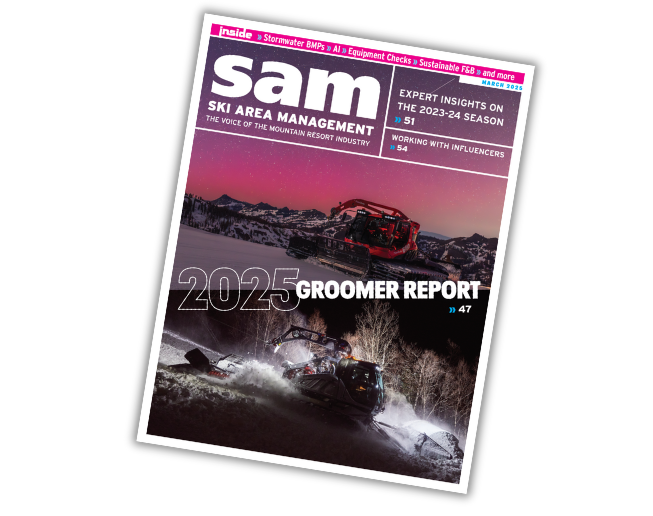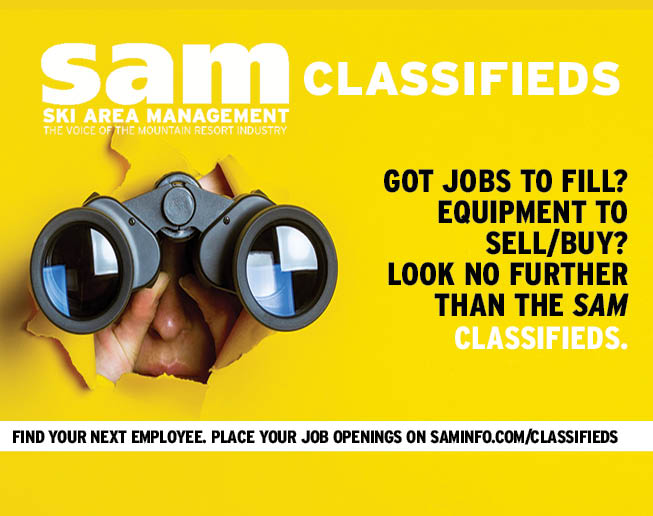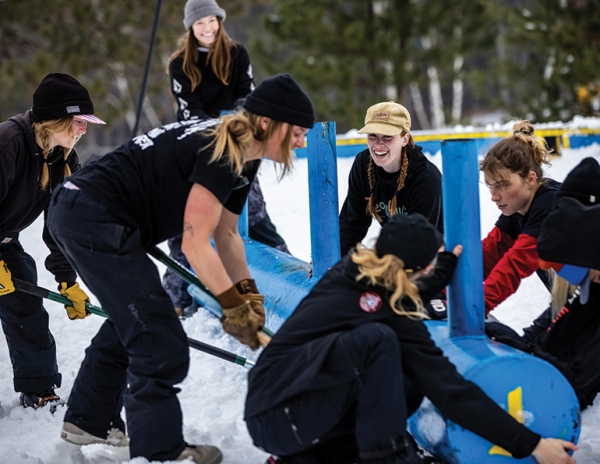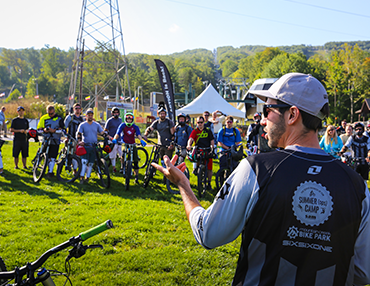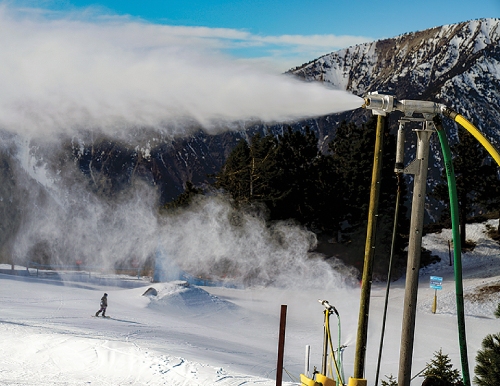This was the subject of the Diversity Summit sponsored by PepsiCo and SAM Magazine and facilitated by the New Haven Consulting Group at Steamboat Resort, Colo., February 2-3. More than 30 invited guests, including diversity consultants, representatives from major corporations such as Sprint, AmTrak, and United Airlines, execs from areas as varied as Winter Park, Waterville Valley and Hyland Hills, and staff from NSAA, SIA and Mountain Sports Media convened to explore the means and benefits of developing more diverse resort organizations and clientele.
One of the first steps was to define "diversity." The New Haven Group termed it "the variety of ethnic, racial, gender, cultural, and other perspectives available to reach company goals."
"Diversity is a buzzword for race or ethnicity," added Rodney Ruffin, director of supplier diversity for Amtrak. "But it's much broader-it's about what everyone brings to the table. It doesn't mean minority."
By this definition, said Reginald Jones, a lawyer with Coudert Brothers' Employment Practice Group and former EEOC commissioner under Clinton, winter resorts already have vast experience with diversity. "It seems to me that skiing has had to integrate snowboarding. That was an exercise in diversity."
Business Lessons
Can diversity (beyond snowboarding) be good for business? Several of the non-ski industry participants said yes. Ethnic populations are willing to spend on activities that matter to them. If skiing and riding become important to people of color, they will become customers. Ruffin took it one step further by saying, "Attracting diverse groups should be business-driven and not a feel-good project. A business-driven plan has more chance of succeeding."
Tammy Edwards, Sprint's director of diversity, said that African-Americans and Hispanics spend more on telecom products, and use them more, than the white population. "They have spending power, and they are growing in number-especially the younger population," she said.
Jones declared that diversity in management can improve a group's decision-making. "Different backgrounds lead to better-quality decisions," he said. The result of groupthink, when everyone has the same point of view, is that you get stuck in a rut. The result is often marketing that misses the mark. He referred to a MacDonald's "Chicken Select" commercial as an example of good intentions gone bad. In the ad, a young African-American airline business passenger breaks into an Aunt-Jemima-style rant-a reaction African-Americans widely saw as racist. The commercial was pulled after just one day. Had African-Americans been involved in developing the spot-which was trying hard to reach a multicultural audience-MacDonald's would not have made this offensive and costly mistake.
Ruffin noted that AmTrak faced some of the same issues winter sports do when it comes to diverse markets, and resorts can learn from the railroad's experience. "We're just not top of mind. We have to reach out to get people to think about us. To recruit, you have to go where the audience is." For example, he said, there are lots of minority and women-owned businesses and the owners set the tone for everyone in the company. They have the financial resources to afford skiing and riding, and they can be the role models who encourage others to join in. "It can happen for you in skiing, because it has happened for us in AmTrak," he said.
Building the Ethnic Base
Much of the Summit focused on the challenges winter resorts face in building diversity among customers and employees. The attendees formed small working groups to ponder these two challenges.
The overriding issue is making diverse groups comfortable in the mountain lifestyle. As Vail senior VP/COO Bill Jensen and Booth Creek VP sales/marketing Julie Maurer observed, choosing to work in the mountains is not a wise financial decision; almost anyone could make more money elsewhere. Instead, it is a lifestyle decision.
Is it a decision that ethnic groups are willing to make? Yes, according to Jeffrey Wortham and Leonard Lee of Youth Enrichment Services (YES). YES organizes many types of adventure programs that introduce urban youth to the mountains, in both winter and summer, and its urban campers become converts fast. "What attracts kids to YES is trying something new," outdoor program director Wortham said in one of the afternoon breakout groups. "The kids really love the outdoors. Once kids get out there, it's not hard at all to instill a love of nature."
And business follows from that love of the outdoors. "As an African-American, I know that I will spend money on an activity I enjoy. That's typical," Wortham added.
Recruiting Diverse Employees
What challenges do areas face in the effort to recruit and retain a diverse employee base? The symposium identified several, among them:
1. Pay. This is especially important to locals (regardless of ethnicity) v. foreigners, who are working in their "summer" season and are thus achieving something close to full-time employment. For locals, resort work is often seasonal. As a result of the relatively low pay, it's not feasible for employees to commute from distant towns and cities. And it's often not economically viable to relocate to the mountains.
2. Lack of mountain awareness. Many of these groups have little familiarity with mountain living, sports and recreation options. They may fear the mountains-avalanches, living in a cold environment, etc.
3. Outreach. Areas find it hard to make the right contacts in ethnic communities to recruit effectively. One area executive suggested that areas have been too easily dissuaded by small efforts that didn't work, and need to step up their efforts.
Challenges or not, most participants agreed that creating a more diverse employee base will increase the industry's chances of attracting and retaining newbies. "People of color like to see people like themselves at the area," said Gary DeFrange, VP and general manager at Winter Park.
Are mountain communities willing to welcome diverse groups? This question sparked one of the most intriguing discussions of the day. In one working group, DeFrange said that the attitude at Winter Park toward people who are "different" is accepting-as it is in most resort areas. As an example, he noted how easily foreign contingents have integrated into resort towns. "We feel we are open and accepting," he said. "This [foreign presence] adds to the experience."
Lee, marketing director for YES, responded by saying, "My experience is not that at all. To me, as an African-American, the Aussie accents add to the air of exclusivity of the areas." The two widely different opinions speak to the need for a diverse staff, one that can recognize the unintended messages and miscommunication that a white-dominated organization puts out.
Where a multicultural labor market already exists, some areas have successfully reached out. "We are in a diverse region," said John McColly, marketing director at Mountain High, Calif. "We made a point to go out and recruit a different, diverse workforce." The area's clientele is 52 percent white, 48 percent ethnic (including 24 percent Asian-Americans), as well as young and, primarily, snowboarders (80 percent). "Snowboarding is the great equalizer-it belongs to youth, of any ethnicity," McColly said.
The Summit also addressed the chicken-and-egg question of which develops first, employees or customers? Julie Maurer noted that, "Most of those who work for us have passion for the outdoors, so that passion has got to be the source for employees."
"There's no feeder system within ethnic communities," said Jensen. "We have to create passion and excitement for winter recreation. Employment will follow."
Love of the mountains notwithstanding, others suggested that areas can help employees find off-season employment in mountain communities, at golf courses or other summer businesses, if full-time jobs aren't available at the resort.
Attracting Ethnic Customers
The challenges to attracting a diverse audience include:
1. Inadequate access and transportation to the mountains.
2. Lack of diversity in the industry. Most managers and top execs are over 45 and white-so we're not good at talking to youth, let alone different cultural groups.
3. Acculturation. It's not easy to teach newcomers the idiosyncrasies of mountain culture. Many cultures have the perception that skiing and snowboarding are crazy, dangerous sports for rich folks with too much leisure on their hands. How do you convince them otherwise? In doing so, areas must also respect the culture(s) of the guests themselves. Russ Coloton, CEO of Hunter Mountain, said it's often important to avoid "singling out" minorities for special treatment, which might make them uncomfortable. In addition, many have found that Asian-Americans and Hispanics are more willing to assimilate into the majority culture; African-Americans may be less willing. Areas need to be sensitive to these attitudes.
4. Limited resources. Areas can't afford to make mistakes in marketing; they end up "fishing where the fish are."
Summit participants said that all four of these challenges can be met, to a large extent, by partnering with existing ethnic organizations that already have credibility with their constituencies.
For example, to get kids to experience the joy of mountain and outdoor recreation, "Identify existing infrastructure dealing with kids and make them allies," said Roberto Moreno of Denver-based Alpino Group. Target urban school systems, which will reach a broad range of youth who might otherwise not have the opportunity to learn about the mountains, even urban whites. This can apply to other age groups as well.
Lee and Wortham agreed that organizations like YES can bring mountains and urban youth together. "We're the equalizer, making both mountains and kids comfortable with one another. If your area is not ready for diversity because you have no experience, that's where YES and Alpino can help. We have the expertise and the contacts, we can tell you what works and what doesn't," Wortham said.
Summit participants identified several potential partners to spread the industry's message:
Travel companies. For example, KYT Tours, an African-American-owned company that packages all-inclusive tours, including parties.
Ethnic PR and marketing firms, as well as business groups-chambers of commerce and professional organizations.
Big corporations with a large number of ethnic employees. This may include existing suppliers or partners.
Ethnic sport organizations, such as the National Brotherhood of Skiers (NBS) and minority golf organizations. In addition to the national NBS management, work with local leaders and even influential members, such as doctors, lawyers, and businessmen who can help reach their professional organizations.
Black colleges and their organizations.
Use the Internet: start at diversityinc.com. Links from resort websites to other organizations are a great way to reach minority markets.
"It doesn't take much. If you reach out to us, we'll pay attention. We're open," Wortham said.
When They Get Here
When Booth Creek areas reached out to the Asian-American market, they realized they needed to be aware of cultural sensibilities. For example, Maurer said, Asian-Americans like to take lessons, but they don't like the obsequious praise doled out by most instructors-it's embarrassing to them. They take lessons, then go practice on their own. Teaching diverse audiences requires understanding (and an adjustment) on the part of instructors.
Do ethnic communities need their own après-ski entertainment, too? Perhaps a little, said Jones, but that's not a major obstacle. "You're selling the mountain lifestyle. The entertainment issue should take care of itself," he suggested. The main goal is to get ethnic audiences to visit in the first place. They can tell you what's missing-they will help you figure out what new activities ethnic audiences will bring to the mountains.
A Long-Term Project
Reaching this diverse marketplace will be a multi-year project. The Diversity Summit was just the first step in what co-sponsor Frank Tansey, national account sales manager of PepsiCo, described as a 10- to 15-year commitment for Pepsi. "Corporate America is doing the best we can on diversity issues. It's our mission to help lay the foundation for ways we can increase multicultural programs and best practices for the mountain resort industry," he said.
That's a mission that we at SAM share. In the next few issues we will go deeper into some of the diversity opportunities we uncovered at the Steamboat Summit-stay tuned.
A special thanks to the sponsors of the Diversity Summit: American Express, Anheuser-Busch, CGPR Public Relations, PepsiCo, Sprint, Steamboat and United Airlines.




